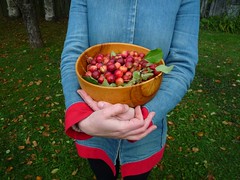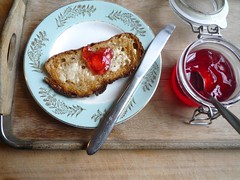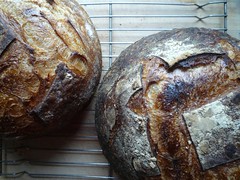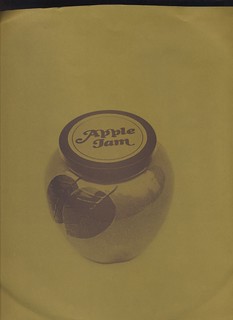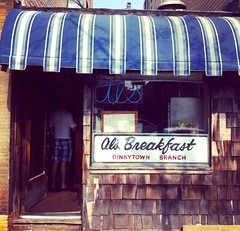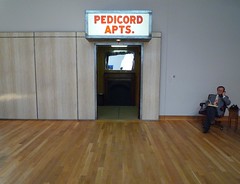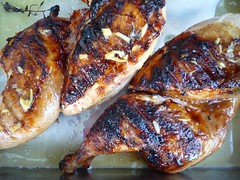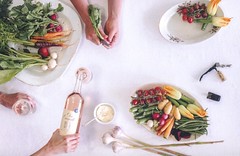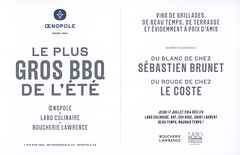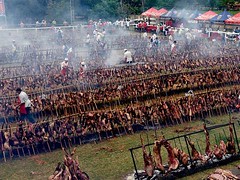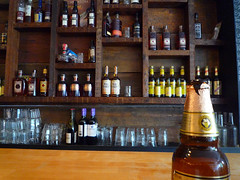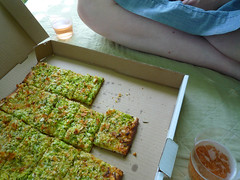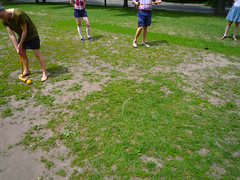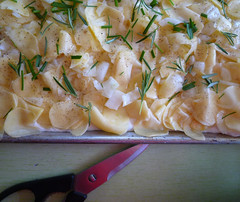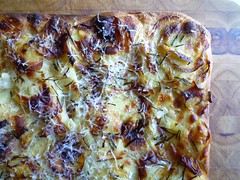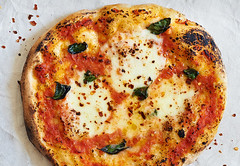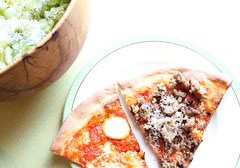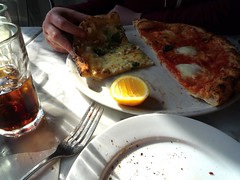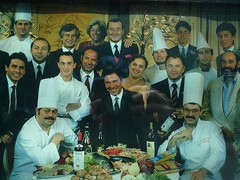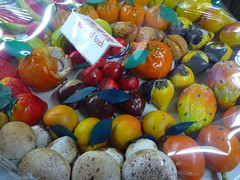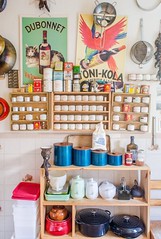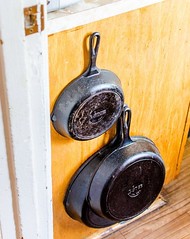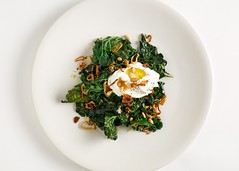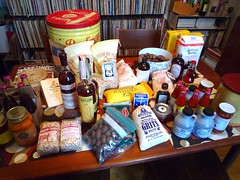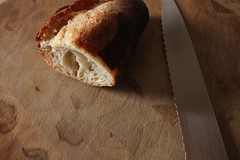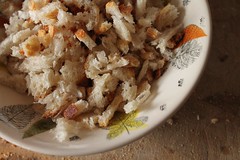Well,
Arthur threatened to spoil our glorious return to
Cape Cod, but, when the storm had finally passed and the winds had settled, the skies cleared up beautifully and things got back to normal.
 fig. a: summer off the Cape
fig. a: summer off the Cape
Our 2013 trip to Cape Cod had been such a hit that we were eager to get back and do it all over again. And because we were there for the same stretch of time, and we'd loved the way our last trip had played out, we were happy to basically replicate our 2013 itinerary.
This meant that there were a few major priorities to our trip:
1. bookstores, book sales, thrift shops & flea markets
 fig. b: books al fresco
fig. b: books al fresco
We probably should commission a custom bumper sticker for our car that reads "I brake for bookstores, book sales, thrift shops, flea markets, particularly promising-looking garage sales, farm stands, pie shops, jam stores, sustainable seafood markets, well-curated wine shops, and discount beverage stores," because we do--we make frequent stops at all these kinds of enterprises, especially when we're on Cape Cod.
We started making such stops almost immediately after we crossed the Sagamore Bridge and began following the 6A (a.k.a., the Old King's Highway) east across the northern edge of the Cape. These stops included the
Parnassus Book Service in Yarmouth Port, which specializes in many things (Americana, Cape Codiana, etc.), but is especially notable for its extensive collection of the work of
local legend Edward Gorey.
The most important stop on our Cape Cod Collectibles tour was without a doubt a return visit to the
Wellfleet Flea Market,
 fig. c: magic carpets
fig. c: magic carpets
which takes place on the grounds of the
Wellfleet Cinemas drive-in theater, on the very southern edge of town, just north of North Eastham, and a few miles from the center of town.
 fig. d: virtual windows
fig. d: virtual windows
You've got to head up closer to the screen to get to "the good stuff" (the stuff that's actually old and/or holds real value, as well as the true Cape Cod characters who are selling it). This is one of our favourite flea markets anywhere, and both times we've visited we've scored plenty of great
finds, but our absolute favourite stand is the "Local Folk Art" stand (formerly known as the
Cape Recycled Art Project, or
C.R.A.P.)
 fig. e: C.R.A.P.
fig. e: C.R.A.P.
where we bought the beach plums and the wild apricots
last year. We had a longer conversation with Mike (a.k.a., the Man From C.R.A.P.) this time around, and we thanked for him for his foraged fruit and told him about the
preserves we made with them. Turns out his fruit foraging prowess has earned him the nickname "Beach Plum Mike." Of course, he didn't have any plums or apricots when we saw him, because it wasn't quite the season, but he did have a lot of whales, mermaids, narwhals, fish, and birds, and his style ranges from American Primitive to Folk Whimsy. Either way, he's one of the best folk artists I've come across over the years, and we made a point of making some new acquisitions.
 fig. f: whale
fig. f: whale
And you'll be happy to know that our Cape Cod bird instantly befriended our
Kamouraska eel.
 fig. g: bird & eel
2. Wellfleet Center
fig. g: bird & eel
2. Wellfleet Center
 fig. h: we grow 'em bigger!
fig. h: we grow 'em bigger!
Speaking of whimsy: there's a fair bit of it in Wellfleet Center, both in the heart of town, and out by the town pier.
 fig. i: book nerds
fig. i: book nerds
They also know how to put on a great book sale (see #1) in Wellfleet,
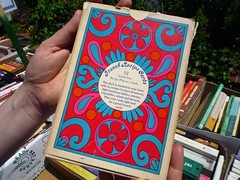 fig. j: French psychedelia
fig. j: French psychedelia
and you never know what you might find, like this bizarre collection of 52 semi-psychedelic "jumbo-size recipe playing cards" featuring the cuisine of France (?).
Sample recipe card: the 10 of spades is "
Poulet aux Amandes (Chicken in White Wine with Almonds)."
Not clear on the concept? Here, let me explain: "Winning luncheons and dinners are in the cards! Deal from this complete deck of delicious hors d'oeuvres, light luncheon dishes, entrees, vegetables, salads and desserts. French Recipe Cards are a pack of fun! Use them for games... as hostess gifts... for party favors."
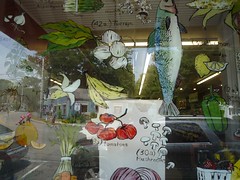 fig. k: window shopping
fig. k: window shopping
The Wellfleet Market is an anchor of the community, and their meat department has provided me with all the quality spare ribs I've required over the last couple of years. They also know how to decorate their windows.
But our very favourite place in Wellfleet Center is
Hatch's, a small operation just off the Town Hall that consists of two halves: Hatch's Produce, a green grocer, which carries a lot of locally grown fruits and vegetables (in season),
 fig. l: Hatch's Produce
fig. l: Hatch's Produce
and
Hatch's Fish Market, which may very well be our favourite place for seafood.
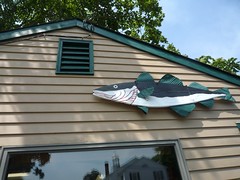 fig. m: Hatch's Fish Market
fig. m: Hatch's Fish Market
We were just blown away by the selection, the freshness, and the affordability of Hatch's seafood last year, and this year we were just as impressed. Once again, we didn't hold back, and, once again, we treated our hosts to a seafood feast on Sunday night, featuring local littleneck clams, wild shrimp, local scallops, and local flounder.
If you don't have access to a kitchen, you can always just pay a trip to Mac's on the pier. There you'll find lobster rolls and other types of seafood sandwiches, oysters on the half-shell, and steamed littleneck clams that are worth waiting on.
 fig. n: waiting for my clams
fig. n: waiting for my clams
And when you visit Wellfleet, be sure to pay a trip to one of the stunning local beaches, preferably oceanside (see below).
3. Ice Cream
The motto of Sundae School, our favourite Cape Cod ice cream shop and soda fountain, is "Don't skip Sundae School," and, believe me, we wouldn't dream of it. Sundae School in Harwich Port is one of our favourite ice cream shops of all-time, and, for us, Bass River Mud is their showstopper. Rich coffee ice cream, roasted almonds, chocolate chunks, and fudge swirl--it's a flavor that lives up to its evocative name,
 fig. o: Bass River estuary
fig. o: Bass River estuary
and it's hard for us to imagine a better combination, or a more successful version of this combination. I meant to take a photograph of it immediately after receiving my cone, but I literally couldn't wait long enough to fire off a shot. This is what a regular serving of Bass River Mud looks like after it's half eaten.
 fig. p: Bass River Mud
4. Barbecue
fig. p: Bass River Mud
4. Barbecue
Monday in Harwich Port has become our barbecue day. I pick up a mess of ribs at the Wellfleet Market on Sunday. I rub them with my special blend
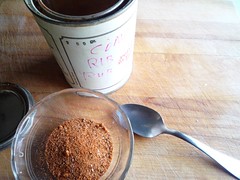 fig. q: special blend
fig. q: special blend
and let the flavours infuse in the refrigerator overnight. And on Monday afternoon, between swims, I put the
3-2-1 method to work. Monday night we have ourselves a good old-fashioned rib-pickin', with all the trimmings, and we wash it all down with bourbon and rye.
5. Swimming
We go swimming as often as we can. That's the rule: get it while you can.
The waters you find off the "tricep" of Cape Cod, facing Nantucket and Martha's Vineyard, get pretty nice and warm and the waves tend to be smaller and choppier.
The waters you find off the "forearm" of Cape Cod, facing the ocean, are bracing, but they're also a remarkably beautiful blue-green, the waves tend to be bigger and better-formed, and the dunes that line the coast are often monumental.
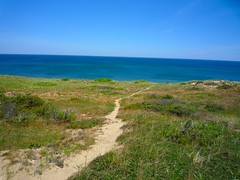 fig. r: this way to paradise
fig. r: this way to paradise
This year, it was Marconi Beach, near Wellfleet, that took our breath away. But, believe me, every single swim, on both coasts of Cape Cod, was a great swim.
6. Souvenirs
It's important to commemorate a summer beach vacation with souvenirs.
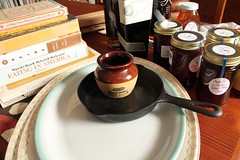 fig. s: s is for souvenirs
fig. s: s is for souvenirs
T-shirts, jam, used books, collectibles, bourbon--whatever it takes. A trip like this can be such a dream come true, such a wonderful blur, that when you get back home you might find yourself needing tangible evidence that you were actually there.
Our favourite souvenirs are edible ones, and the thing we knew we'd miss the most when we left Cape Cod was the seafood, so we made a point of scooting up to Wellfleet and popping into Hatch's again before we headed back to Montreal. Once again, we picked up a bunch of local specialties, like shrimp, scallops, and cod (natch), but the treat we were most excited about were our two dozen littleneck clams. Those Wellfleet littlenecks had been one of the highlights of our trip, and we were determined to extend the good tidings all the way back home. We weren't exactly sure what we were going to do with them, but on the drive back I had a flash of inspiration: clam pizza!
So the day after, that's exactly what I did: I made a couple of clam pies using the
Roberta's method.
Once you've got your
two pizza doughs ready to be baked...
Clam Pizza
24 littleneck clams
2 x 125g buffalo mozzarella or fior di latte
parsley, minced
chives, minced
red pepper flakes
reserved clam juice
extra-virgin olive oil
lemon wedges
Place a pizza stone in your oven, and preheat it as high as your oven will go. I recommend doing so at least an hour before you plan on baking.
Wash and scrub your littleneck clams, rinsing them several times.
 fig. t: raw
fig. t: raw
Place them in a medium pot with 1/2" of salted water and cover the pot. Bring the pot to a boil, turn the heat down to medium-high, and steam the clams until all the shells have opened. Generally 6-10 minutes is how long it's going to take, but these super-fresh Wellfleet littlenecks only took about 4 minutes. The common wisdom is to discard those clams that don't open.
Scoop the clams into a bowl,
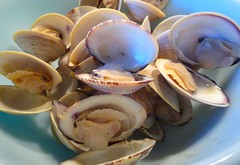 fig. u: cooked
fig. u: cooked
making sure to reserve the clam broth in the pot.
When your clams have cooled enough to handle, remove the clam meat from the shells and mince them on a cutting board. Divide the minced clam meat into two equal portions.
Slice both portions of mozzarella as thinly as possible and gather together your other ingredients.
Add about a tablespoon of your clam broth to about two tablespoons of extra-virgin olive oil and stir well. This will be your drizzling oil. (Save the rest of the clam broth for another use, like making spaghetti with clam sauce, but make sure to use it while it's still fresh.)
When your oven is ready to go, stretch and form your pizza dough into a 12" round with a properly shaped lip to it. Spread half your mozzarella slices over your dough, placing the larger pieces closer toward the rim and the smaller pieces closer toward the center. (Buffalo mozzarella gives off a considerable amount of liquid. When you're baking a thin-crust, "white" pie like this, you want to try to avoid having liquid pooling in the center as much as possible.)
Scatter half your clam meat evenly over the pie. Sprinkle minced parsley, minced chives, and red pepper flakes over top. Grind some black pepper overtop and sprinkle a pinch of sea salt. Drizzle the pie with your olive oil/clam broth concoction. Place it in the oven and bake following the Roberta's method.
Remove your pie from the oven when it's baked to perfection and allow it to cool for about a minute. This will allow the molten cheese to set and make it easier for the pizza to be sliced. It will also make it easier for the pizza to be eaten, and help you to avoid law suits.
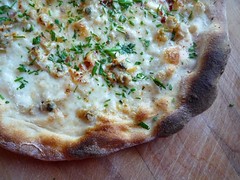 fig. v: clam pie 1
fig. v: clam pie 1
Serve with lemon wedges and encourage your guests to squeeze a little lemon juice over their slices.
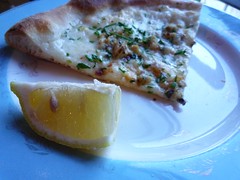 fig. w: clam pie 2
fig. w: clam pie 2
Repeat instructions with dough #2.
The AEB Clam Pizza was a tribute to the clam pie we had at
Motorino back in April, but it was also a pretty tasty tribute to Wellfleet and Cape Cod. Those clams were so tender, so briny, so vibrant, it was almost like we'd never left.
Of course, in order to make it possible to bring back edible souvenirs such as these on a road trip such as this, a cooler is essential. Make sure to buy enough ice to keep everything fresh on the long drive back.
Postscript: Yes, we miss the towns, the beaches, and the seafood of Cape Cod, but it wouldn't mean quite as much without good friends. What we really miss most of all is experiencing Cape Cod with our close friends R & MA and the rest of the Harwich Port Crew (you know who you are!)--the beers, wine, and cocktails; the al fresco dining; the beach time; the laughs; the feats of sporting prowess; the dance moves; the trips down Memory Lane; the word play... OMC! You guys are awesome!
aj


